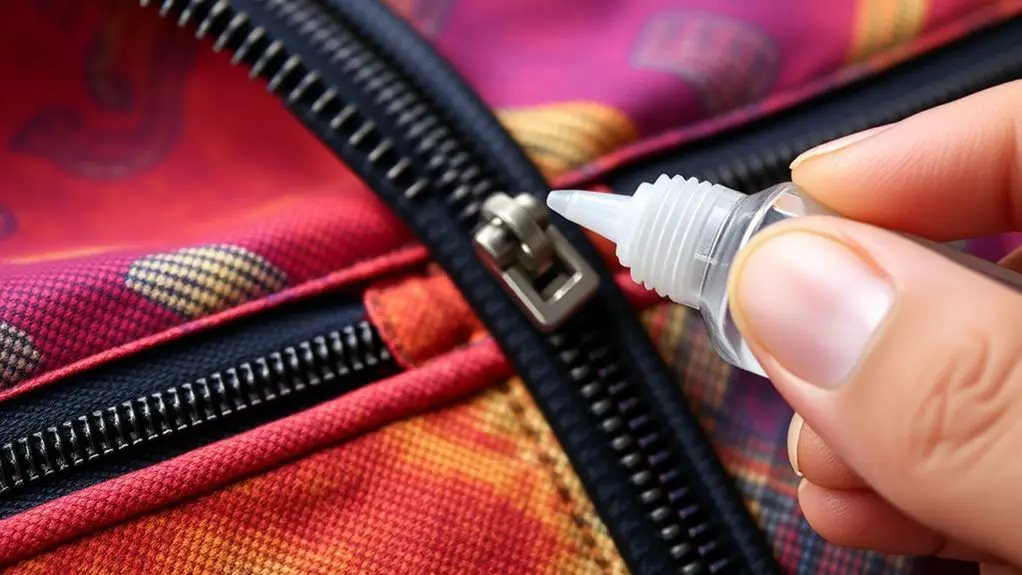To make your plastic zipper glide smoothly, start by checking for any dirt or fabric caught in the teeth. A soft brush and some warm soapy water can work wonders. Once clean, try a bit of lubricant like graphite from a pencil—just rub it along the sides of the zipper track. If your slider's loose, gently squeeze it with pliers. And don't forget to inspect it regularly; a bit of preventive maintenance goes a long way. Stick around, and you'll uncover even more handy tips to keep that zipper in top-notch shape!
Key Takeaways
- Regularly clean the zipper track with a soft-bristled brush to remove dirt and grime that may obstruct smooth movement.
- Apply a specialized lubricant along both sides of the zipper track for enhanced glide and operation.
- Use graphite pencil to provide natural lubrication without staining the fabric, ensuring easy movement of the slider.
- Inspect for misaligned or bent teeth and use pliers to realign or adjust them for optimal functionality.
- Store items carefully to minimize strain on zippers, preventing wear and tear that can hinder smooth gliding.
Identifying Zipper Problems
When you're in a hurry to zip up your jacket or bag, the last thing you need is a zipper that's acting up. If your zipper feels stuck, it could be due to obstructions like fabric or threads blocking the slider. Take a second to inspect it; sometimes, a little tug can help realign misaligned teeth. If the teeth seem bent or damaged, you might need to replace them or the whole zipper if it's really bad.
Another common issue is when the zipper fails to close properly. This can happen if the teeth aren't lining up correctly. If you notice this, don't panic! Gently pulling the slider up and down can sometimes fix the problem. For more stubborn cases, pliers can help you adjust those misaligned teeth.
Keeping your zipper in good shape means regular cleaning and lubrication. Dirt and debris can really mess things up, causing your zipper to stick or catch.
Effective Cleaning Methods
Keeping your zipper clean is key to making it glide smoothly. Regular maintenance, such as cleaning, can prevent dirt and debris from interfering with zipper functionality and enhance your overall experience.
If you want your zipper to operate smoothly and avoid annoying jams, here are some effective cleaning methods you can try:
- Use a Soft-Bristled Brush: Grab a toothbrush or a soft-bristled brush and gently scrub the zipper teeth. This helps remove dirt and debris without causing damage.
- Dish Soap and Warm Water: Mix some dish soap with warm water and soak the zipper for a few minutes. This will lift stubborn grime. Just be sure to rinse it thoroughly to avoid any residue buildup.
- Vinegar for Stuck Zippers: If you're dealing with rust or sticky residue, a vinegar-soaked cotton ball can work wonders. Let it sit for a few minutes before wiping it clean to enhance glide.
Regular cleaning should be a part of your maintenance routine, especially for outdoor garments exposed to dirt.
After cleaning, always dry the zipper completely to prevent moisture-related issues and enhance the performance of your zipper.
For best results, consider establishing a routine that includes monthly lubrication to prolong zipper lifespan and ensure smoother operation. Happy cleaning!
Lubrication Techniques
Lubricating your zipper is like giving it a little TLC, and it can make a world of difference in how smoothly it operates. If you've ever dealt with a stuck zipper, you know how frustrating it can be. So, let's get it gliding again!
First off, consider using a specialized lubricant. Just apply a few drops along both sides of the zipper track, and you'll notice an instant improvement.
If you want to stick to household items, grab a graphite pencil. Rubbing it along the zipper track provides natural lubrication without staining your fabric.
For a quick fix, try olive oil. Just apply a few drops above and below the zipper, but remember to clean it off afterward to avoid any unpleasant smells.
Bar soap is another handy option; simply rub it along the teeth of the zipper and wipe off any excess.
Make it a habit to check and lubricate your zippers every month, especially if you use them often. Keep that zipper happy, and you'll keep it from getting stuck!
Repairing Zipper Components
After you've given your zipper some love with lubrication, it's time to tackle any pesky issues with its components. Zippers can be a real pain when they start acting up, but a little DIY magic can often fix them.
Here are three quick fixes you can try:
- Slider Trouble: If your slider feels loose, grab some pliers and gently compress the slider plates. This should help tighten them up so your zipper moves smoothly again.
- Misaligned Teeth: If you find your zipper separating after fastening, check the teeth at the back of the zipper. Use pliers to align any misaligned sections to keep everything in sync.
- Slider Off Track: If your slider is off track, don't panic! Simply feed the zipper teeth back into the slider from the correct end. If needed, a flathead screwdriver can help push them into place.
While missing teeth often need a pro's touch, a quick dab of clear nail polish can help thicken the remaining teeth temporarily.
If your pull tab's broken, just open the slider, insert a new tab, and close it up. You've got this!
Preventive Maintenance Tips
When it comes to zippers, a little preventive maintenance can go a long way in keeping them in tip-top shape. You don't want a jammed zipper ruining your day, right? So, regularly clean the zipper track with a soft brush and some soap or vinegar to clear out any debris. It's a simple task that can make a huge difference!
Next, apply zipper lubricant—like a wax stick or specialized lubricant—once a month, especially for those frequently used items. This keeps the zipper gliding smoothly without any hiccups. And don't forget to inspect your zippers for wear signs. Look for bent teeth or misalignment before they become bigger headaches.
Make sure to handle zippers gently; avoid yanking or pulling too hard. Heavy items should be stored carefully to prevent strain on the zippers. Here's a quick reference table to remember:
| Task | Frequency | Importance |
|---|---|---|
| Regularly clean | Monthly | Prevents jam |
| Apply lubricant | Monthly | Smooth glide |
| Inspect for wear signs | Every few months | Catches issues early |
Keep these tips in mind, and your zippers should slide like a dream!
Frequently Asked Questions
How to Make Plastic Zippers Slide Easier?
To make your plastic zippers slide easier, clean the tracks with soap, apply a little bar soap or zipper lubricant, and check for misaligned teeth. You'll be zipping smoothly in no time!
What Is the Best Lubricant for a Plastic Zipper?
You'll want to try specialized zipper lubricants like Zipper Ease for the best results. If you're in a pinch, bar soap or graphite from a pencil works surprisingly well and won't leave a mess!
How to Make a Zipper Move More Smoothly?
If your zipper's not moving smoothly, try cleaning the track first. Then, rub some bar soap or use a pencil on it. Always zip from the bottom up to keep it aligned and snag-free!
What Can I Use on a Plastic Zipper That Is Hard to Zip?
If your plastic zipper's hard to zip, try using a bit of household oil or even bar soap. Rubbing a pencil along the teeth can help too. Just keep it clean and lubricated!

